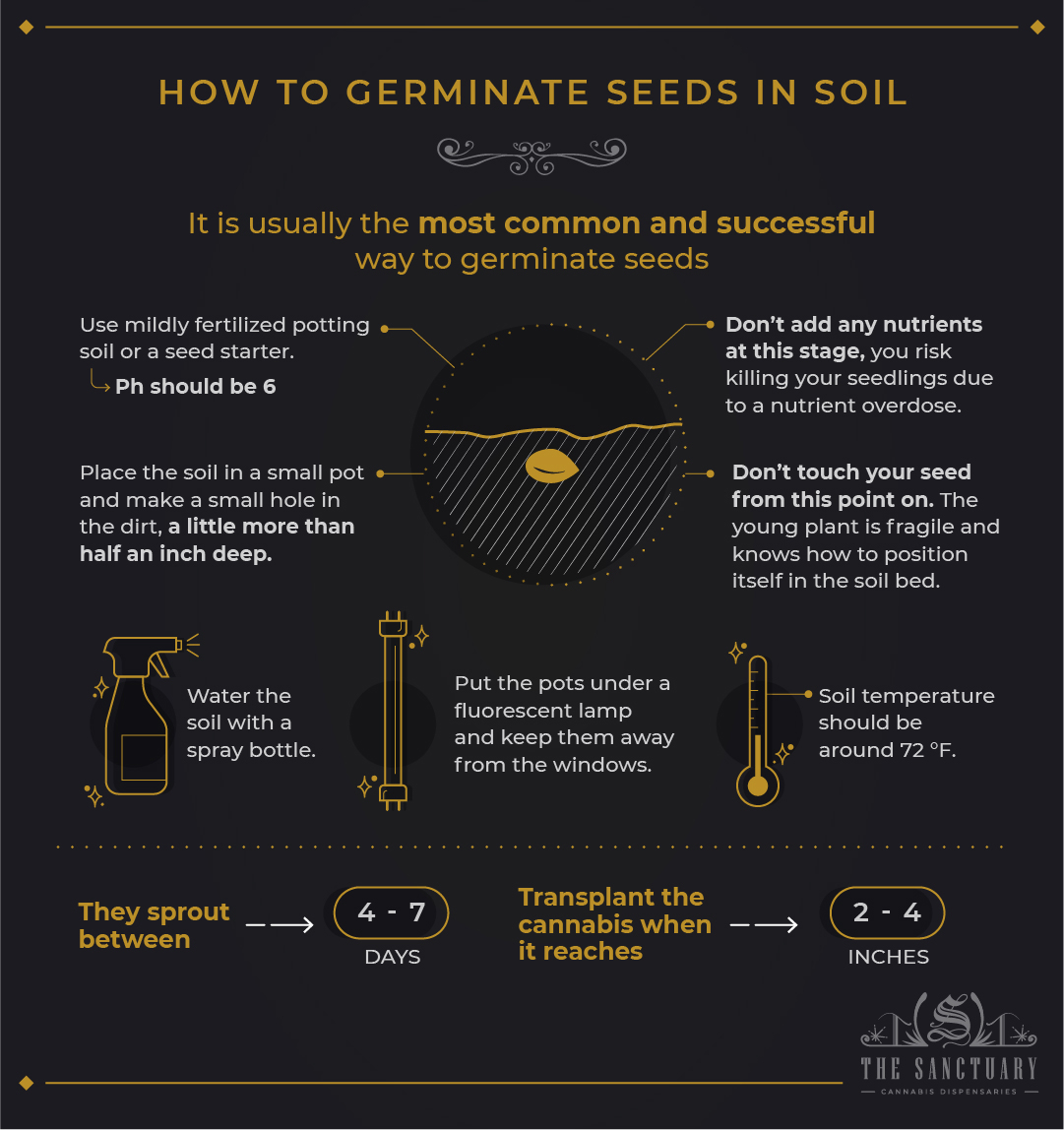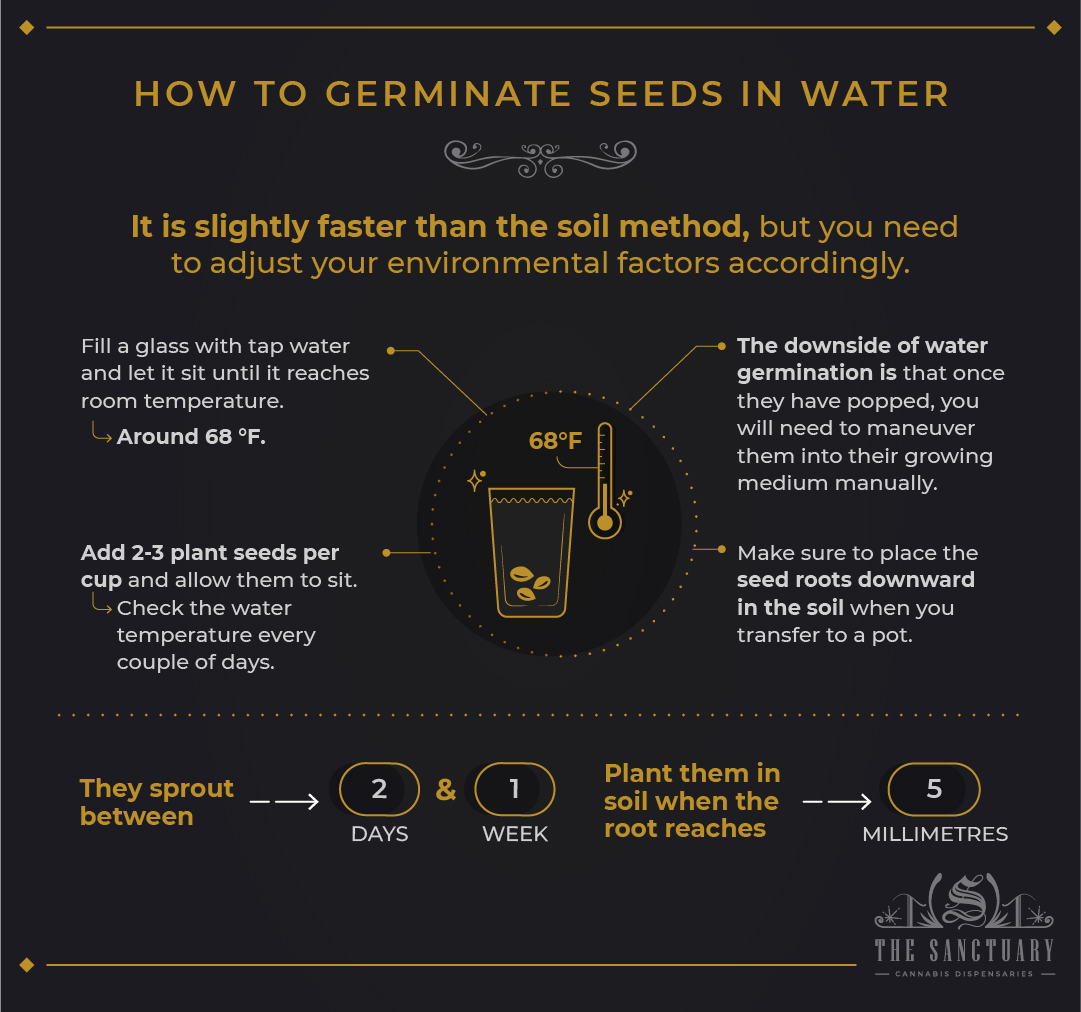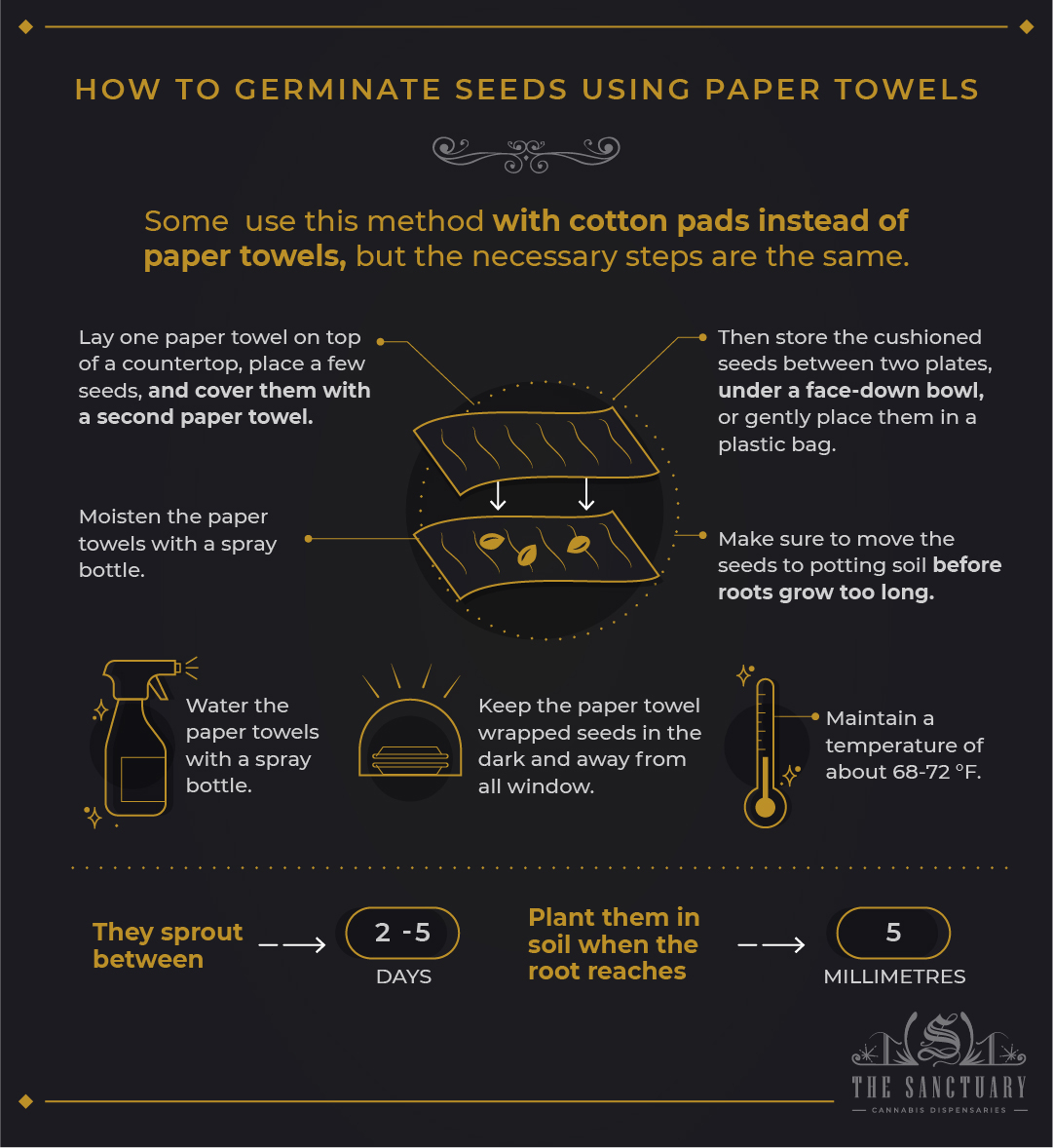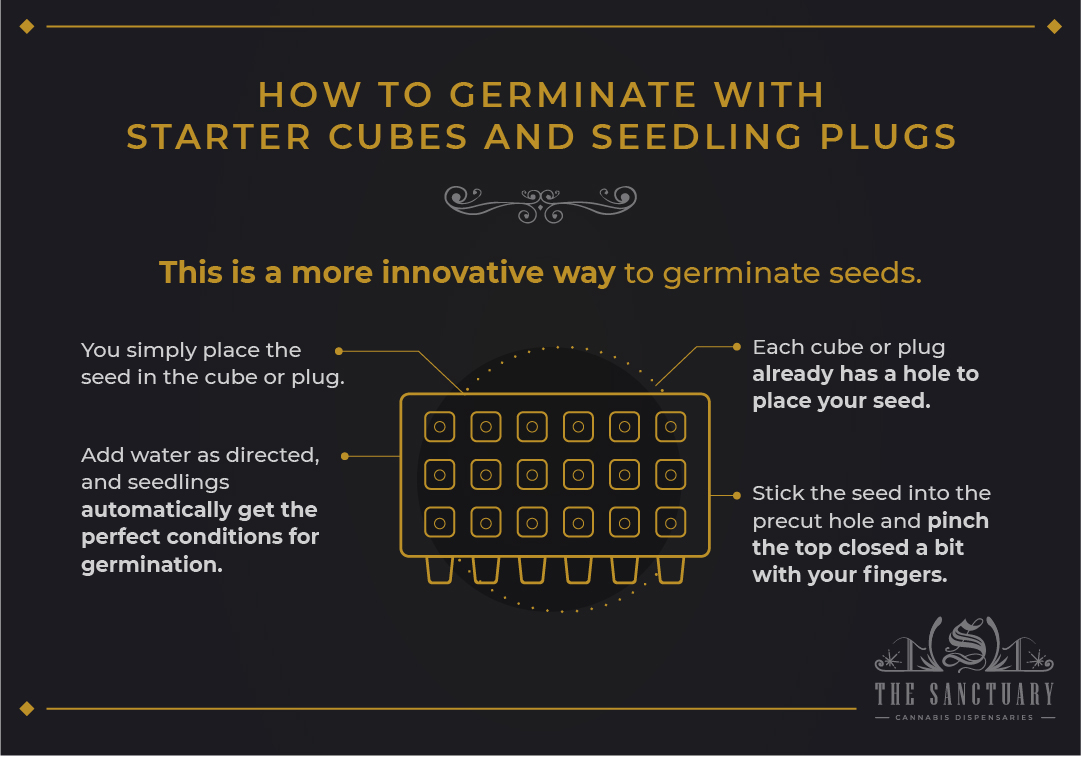Iftikhar Alam
Author
Reviewed by Cannabis Experts
Published on: April 22, 2021 | Updated on: September 1, 2024
There are numerous phases of cannabis cultivation that must be completed before you may be greeted with copious amounts of dank buds. You won’t have a plant to harvest unless you can successfully germinate cannabis seeds.
Germination is the process through which a seed sprouts into a new plant. Often known as “popping,” germination is the first step in beginning a cannabis garden.
Picking out good quality seeds
Cannabis seeds may be obtained from a variety of places, although they are most often purchased online. Because there are so many different internet seed sellers, it’s crucial to pick one that you can trust.
Regardless of where you obtain your seeds, it is a good idea to check them carefully before planting. Seeds will germinate in the majority of cases; nevertheless, poor-quality seeds will result in a weaker plant. Unfortunately, you won’t find out until the vegetative and flowering periods are well underway.
When purchasing seeds, make sure they are ripe and have a dark brown color with lighter highlights and a firm feel. You don’t want a seed that feels fresh and seems green, as this suggests that it hasn’t fully matured. Once you’ve got your cannabis seeds, make sure you have enough room for your plants to develop and thrive.
Preparing to germinate cannabis seeds
The act of germination is important in the production of cannabis. Seed germination is the basis of every cannabis plant, and there are actions that can be performed to increase the likelihood of successful popping. Some growers, for example, increase germination attempts by soaking seeds in a compost tea for 12 hours or in a solution of 1 percent hydrogen peroxide prior to planting to eliminate any harmful bugs.
The environment in which seeds germinate has an impact on the final result. There are a variety of germination methods, however, they all require:
- Moisture is required for the seed to swell and break free from its shell.
- Minimal intervention to avoid accidentally breaking the fragile structures.
- Temperatures that are similar to those of spring (between 68-72 degrees Fahrenheit).
A single root will take form in the presence of moisture before gradually growing into the cannabis plant we know and love. Seeds will begin to grow within 12-36 hours of being exposed to moisture under the correct conditions.
The length of time it takes to germinate depends on how great your germination environment is. Even the worst grower can get a seed to germinate, but it will take a few weeks and will, of course, result in a weaker plant.
How to germinate seeds in soil
 The most popular and generally effective technique of germinating cannabis seeds is to plant them in the soil where they will be grown. Because the delicate root is shielded by the soil, this approach is ideal for ensuring that immature seeds have minimal disturbance. It is ideal for plants to develop in the most natural way possible.
The most popular and generally effective technique of germinating cannabis seeds is to plant them in the soil where they will be grown. Because the delicate root is shielded by the soil, this approach is ideal for ensuring that immature seeds have minimal disturbance. It is ideal for plants to develop in the most natural way possible.
If you’re going to utilize soil, be sure you have the proper kind. Use seed-starting or potting soil that has been lightly fertilized. It should have a pH level of around 6. This sort of soil contains spores and nutrients that aid the growth of new weed plants. At this point, don’t add any nutrients; potting soil has adequate nutrients for the first 2 weeks of the plant’s existence. If you apply any additional fertilizer, you risk nutritional overdosing and harming your seedlings.
Place the soil in a tiny pot and make a small hole in the dirt with your finger or a pencil, about half an inch deep. Place the seed in the hole and cover it with dirt. Do not handle the seed beyond this stage. Seedlings are delicate, yet they understand how to place themselves in the dirt.
The seed will have a root if it has already germinated. Place the root in a downward position. Spray water onto the soil gently using a spray bottle and place your pots beneath a fluorescent light. Seeds should be kept away from windowsills since the temperature is too fluctuating for germination. The soil temperature should be kept at 72 degrees Fahrenheit.
Every day, keep an eye on your soil and maintain it to stay wet. You should observe small stems growing from the dirt in 4-7 days.
Move your weed sprouts to bigger pots so that roots can spread out comfortably around the time the seedling stems reach 2-4 inches in height.
Germinate seeds in water

Seeds can also be germinated by immersing them in water. It’s a little quicker than the dirt technique, but you’ll have to modify your environment variables accordingly.
The key is to not soak the seeds for too long. The seeds will usually show their tail within 24 to 48 hours, but you may leave them soaking for up to 7 days without fear.
When seeds germinate in water, they sink to the bottom once they’ve been wet. Water germination is beneficial because it ensures that the proper quantity of moisture is present for seedlings to germinate. It can help shatter open the shell, pre-spouting the plant right before your eyes if done for a brief length of time. Water germination speeds up the process by removing the need for the plant to push through the soil.
Fill a glass halfway with tap water and let it sit at room temperature for a few hours to germinate. The temperature should be between 68 and 70 degrees Fahrenheit. Do not include any nutrition. Watch for any changes after dropping 2 or 3 cannabis seeds into the water. Every other day, refill the glass with fresh water while keeping it at the same temperature.
The seeds should begin to divide after 2 to 4 days. You can plant your seeds at any time, but they must be planted after the roots are 5 millimeters long.
Germinate seeds by using paper towels

You don’t have to use paper towels; there are a few other objects around the house that will do the job just as well. You can use coffee filter papers, newspaper, or cotton wool pads as examples.
First and foremost, wet your paper towel. Make sure the paper towel is thoroughly wet before placing it onto a holding container such as a plate or Tupperware. Spread a few seeds across the paper towel. Make sure there are a few centimeters between each seed so they don’t touch.
With a zip lock bag to seal your container. This essentially creates a greenhouse-like atmosphere, allowing your seeds to grow a bit faster. Place your new mini-greenhouse somewhere that will maintain a constant temperature of approximately 68 degrees Fahrenheit while being out of direct sunshine.
You should notice your seedling growing in about a week. It’s time to move them into a dirt container when you notice this. Take your time and use the tweezers; don’t touch them with your bare hands because this might cause them to be destroyed.
Germinate with starter cubes and seedling plugs

Using specially designed starting cubes and seedling plugs is a more creative approach to grow seedlings. Cannabis germination is simple with these plugs. Simply insert the seed in the cube or plug, add water as indicated, and the seedlings are automatically provided with ideal germination conditions. This is one of the most straightforward germination procedures, with little opportunity for error.
Each cube or plug already has a hole in it where you may plant your seed. Simply place your seed in the precut hole and seal the lid with your fingers. Don’t worry, you won’t be able to screw this up. You should be fine as long as the seed gets in there.
The content provided on this blog is for informational purposes only and does not constitute medical, legal, or professional advice. Cannabis use is subject to local laws and regulations, which vary widely by jurisdiction. Always consult with a healthcare professional before starting any new treatment or altering an existing treatment regimen. The authors and publishers of this blog are not responsible for any actions taken based on the information provided herein. Use cannabis responsibly and in accordance with applicable laws. This blog is intended for adults aged 21 and over. The Sanctuary Dispensaries D186, D187.








